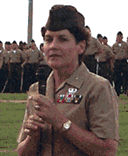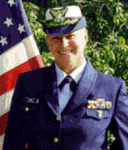

Even though women have officially served in the military since 1901, when the Army Nurse Corps was created, for many years the highest rank they could hold was Colonel. Promotion to "Star Rank," a military term for admirals and generals, was not an option for career minded military women.
Finally in 1967 a bill to promote military women to star rank worked its way though the bureaucratic maze and was signed into law. In June of 1970 the Army took the first step and promoted the chief of the Army Nurse Corps Colonel Anna May Hayes to Brigadier General - the very first woman to wear a star. Literally minutes later Colonel Elizabeth P. Hoisington, Women's Army Corps Director, received her new star. Over the next two years three more women were promoted to general, and in the Navy Nurse Corps, to admiral - the Navy's equivalent to brigadier general. The Marine Corps followed some years later.
Two years after the first women became star officers young Frances C. Wilson was commissioned a second lieutenant in November 1972 when she was was the honor graduate and recipient of the Leadership Award from the Marine Corps Women Officer Basic School. Also in the 1970s her sister Mary entered the U.S. Coast Guard Reserve as a direct-commission officer upon graduating from Ohio State University.
Now in the year 2000 they both wear stars and hold the distinction of being the military's highest ranking sisters -- Admiral and General. The General: Brigadier General Frances C. Wilson, USMC

Marine Brigadier General Frances C. Wilson has assumed command of the 3rd Force Service Support Group (FSSG), headquartered on Okinawa, Japan. She is currently the only female general officer in the Marine Corps. Marine Lieutenant General Carol A. Mutter, the first woman in the Department of Defense to be selected to wear three stars, retired.
Highlights of Brig. Gen. Wilson's 26-year Marine Corps career include command of the 4th Recruit Training Bn., Marine Corps Recruit Depot, Parris Island, S.C., and a Federal Executive Fellowship at the Brookings Institution in Washington. From July 1991 to 1993, she was assigned to the headquarters staff, Marine Forces Pacific, Hawaii. She then concurrently commanded Camp H. M. Smith and Headquarters and Service Bn., Marine Forces Pacific, before returning to Washington in January 1995. There, she served as the Secretary of the Joint Staff at the Pentagon through July 1997, before taking over the helm of Marine Corps Base Quantico.
The Admiral: Rear Admiral Mary P.O'Donnell, USCGR

For the first time in the Coast Guard Reserve 58-year history, a woman has been selected to the rank of rear admiral. CAPT Mary P. O'Donnell has served in the Coast Guard Reserve for the past 27 years. She began her career as a recruiter, and served on the first all-Reserve district inspection team. Her assignments have included both traditional Coast Guard missions and six years in the joint environment of expeditionary warfare. As a member of the Naval Coastal Warfare community, assignments have included participation in fleet training exercises in Korea, Bahrain and Australia. She has been the commanding officer of Harbor Defense Command Unit 111, Composite Naval Coastal Warfare Unit 111, Reserve Unit Yerba Buena Island, and Reserve Unit Station Fort Point. Other assignments include Plans Department head, Naval Coastal Warfare Group One; deputy group commander, Reserve Group San Francisco; deputy group commander, Maritime Defense Zone.
The proud mother of these two esteemed military women, (Mrs.) Frances Wilson, widow of Air Force Colonel John B. Wilson, taught her daughters well. And they credit her with teaching them that they could be anything they wanted to be. 
This wonderful lady, now 83, is the only mother of two women flag officers - two women who have accomplished amazing things in education, business, and the armed services. Accomplished them in part because the senior Frances Wilson taught her daughters so well.
As an interesting aside in 1999 - the year that Mary P. O'Donnell was selected for Admiral - the Coast Guard Reservist Magazine featured a 100th Birthday salute to Captain Dorothy Stratton, the first director of the SPARs - the women in the Coast Guard.

How fitting that Captain Stratton was able to see the day arrive when a woman could and would become an Admiral. Captain Stratton will certainly also be pleased over the August 12, 2000 launching of the Coast Guard Cutter SPAR - named after the many women who served in the United States Coast Guard during World War II. "Semper Paratus, Always Ready," a commonly known phrase describing all members of the Coast Guard, was condensed to the S.P.A.R. acronym to symbolize these women.The CGC SPAR is a buoy tender that is 225 ft long, has a beam of 46 ft, and will serve in Kodiak, Alaska. It has a draft of 13 ft and a displacement of 2000 long tons. It's crew will have a complement of 6 officers and 34 enlisted men and women. Although designed to replace the World War II vintage 180' buoy tenders, the SPAR will also perform the following Coast Guard missions: Marine Environmental Protection, Search and Rescue, Defense of the Exclusive Economic Zone and National Security, and Domestic Ice Breaking.
Please note: In accordance with Title 17 U.S.C. section 107, this material is displayed without profit or payment for those who have expressed an interest in receiving this information for non-profit research and educational purposes only. Photos and images are from the National Archives, The Naval History Center, The U.S. Army, USMC, U.S. Navy, USAF, U.S. Coast Guard, the Defense Visual Information Center, The Army Nurse Corps, and the personal collections of this author. Nothing on this site is for sale nor is it a commercial venture of any kind - it is a one person page for, and about military women - by one retired military woman. Contents copyrighted 2000 by Captain Barbara A. Wilson, USAF (Ret).